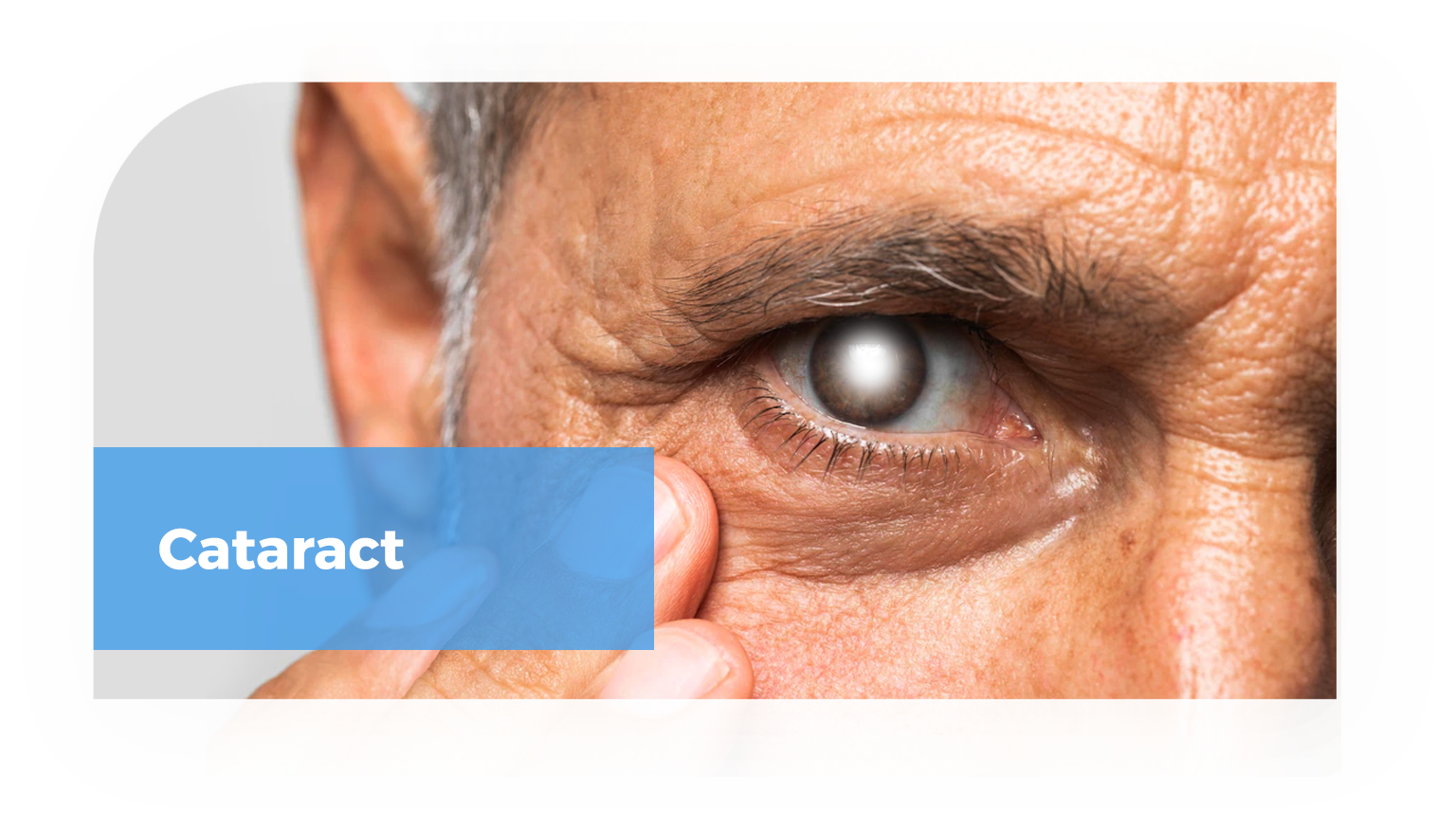
Cataract
Cataract is the clouding of the normally clear lens of your eye.
Why do you get cataract?
Advancing age is a primary reason for cataract. With age, protein of the lens turns opaque. Other causes of cataract are metabolic disorders such as diabetes, excessive exposure to sunlight, prolonged use of corticosteroid medications, statin medicines used to reduce cholesterol, hormone replacement therapy, previous eye surgery, lifestyle disorders like heavy alcohol consumption, smoking, injury or inflammation of the eye.
How do you know that you have cataract?
Initially cataract has little effect on your vision. Then you may notice that your vision is blurred a little, like looking through a cloudy piece of glass.


The most common symptoms of a cataract are:
- Cloudy or blurry vision
- Colors seem faded
- Headlights, lamps, or sunlight may appear too bright. A halo may appear around lights
- Poor night vision
- Double vision or multiple images in one eye (This symptom may clear as the cataract gets larger)
- Frequent prescription changes in your eyeglasses or contact lenses
These symptoms also can be a sign of other eye problems. If you have any of these symptoms, check with your eye care professional.
Symptoms experienced and how soon they occur, will depend on the type of cataract you have.
Risks of having cataract:
- Many risks are associated with driving and operating large equipment or machinery.
- If one eye has a significant cataract and the other eye does not, you may lack the ability to accurately judge distances.
- It is very important that your cataract treatment plan includes proper counseling regarding the impact of reduced vision.
- However, if you have other eye conditions in addition to cataracts, talk with your doctor about the risks, benefits, alternatives, and expected results of cataract surgery. You and your eye doctor should take the decision together.
Cataract Diagnosis:
Your ophthalmologist will examine and test your eyes to make a cataract diagnosis. Tests include:
- Refraction and visual acuity test
- Dilated fundoscopy
- Slit-lamp exam
- Retinal exam
Once I have a cataract diagnosis, what should I do to prevent it from getting worse?
- Get the right eyeglassesor contact lenses to correct your vision
- Protect your eyes from UV lightby wearing hat and sunglasses that block at least 99% of UV rays
- Live a healthy lifestyle. Good nutrition with green leafy vegetables, fruit, and other foods with antioxidants as vitamins A, C, and E is highly recommended
- Quit smoking as it is a key risk factor
- Use brighter lights for reading and other activities. A magnifying glass may be useful, too
- Limit driving at night once night vision, halos or glare become problems
- Take care of any other health problems, especially diabetes
- Check medicinal side effects
- Avoid steroid eye drops
- Have an eye examination every year
- When it becomes difficult to complete your regular activities, consider cataract surgery
- Make an informed decision about cataract surgery
Is Cataract curable?
Cataract never goes away on its own. It may stop progressing altogether after a certain point or may continue to grow leading to blindness if left untreated. When it forms, surgery is the only way to treat it. In cataract surgery, the surgeon removes the clouded lens and puts an Intra Ocular clear, artificial Lens (IOL) in your eye. This is generally a safe, outpatient procedure. Your vision will be as good as pre-cataract days, though you may need to wear glasses. Over the years the size of corneal incision made during cataract surgery has considerably reduced and also this surgery has moved from vision restorative to refractive surgery, so that you have reduced need of glasses. Best cataract treatment requires the combination of expertise of experienced doctors and latest technology working together. Surgery techniques used are Phacoemulsification and Micro Incision Cataract Surgery. Both are walk-in, walk-out, stitchless, bloodless, painless procedures in which cataract is emulsified and removed using an ultrasonic phacoemulsification probe and foldable IOL is implanted. The only difference is Phacoemulsification requires a small incision of 3.2 mm and in micro-incision cataract surgery, only a very small incision of about 2mm is made, leading to improved visual outcome & quicker healing and post procedure recovery for the patient.
Surgery is usually performed on one eye at a time to minimize potential complications. Cataract surgery is performed in an outpatient surgical center with local/topical anesthesia. Patients are generally released directly after surgery.
How long does it take for a cataract to be removed?
Uncomplicated cataract surgery often takes no longer than about 10 minutes to perform. But immediately after the surgery, you will need to rest in a recovery area till you are comfortable. Typically this takes about 30 minutes – 1 hour.
Do cataracts grow back?
During cataract surgery, the cloudy lens is removed. The artificial lens does not form cataracts. While cataract does not grow back, it is not uncommon several months (or years) after cataract surgery to notice blurry vision similar to what you experienced with the original cataract.
Which lens is best after cataract surgery?
When you decide to have cataract surgery, your doctor will talk to you about IOLs and how they work. New IOLs are being developed all the time to make the surgery less complicated for surgeons and the lenses more helpful to patients.
- Monofocal Intraocular Lenses (IOLS) are artificial lenses implanted in the eye of adult patients following cataract surgery and are designed to allow for clear distance vision. However, you will likely still need glasses for reading and for distance vision particularly if you already have astigmatism.
- Toric Intraocular Lenses (IOLS) are artificial lenses designed to correct pre-existing corneal astigmatism, which is the inability of the eye to focus clearly at any distance because of different curvatures on the cornea, and provide distance vision.
- Multifocal Intraocular Lenses (IOLS) are artificial lenses (sometimes called “presbyopia‐correcting IOLS”) designed to allow for clear distance, intermediate, and near vision with the potential to be more independent of the need to use glasses for daily tasks.
- Multifocal Toric Intraocular Lenses (IOLS) are artificial lenses designed for astigmatism patients and to allow for clear distance, intermediate, and near vision with the potential to be more independent of the need to use glasses for daily tasks.
Reduce your need for glasses
When you have astigmatism and don’t choose an astigmatism-correcting lens (toric IOL), you’ll still have to wear glasses or contact lenses to see clearly at distance after surgery. If you opt for toric intraocular lens, these will not be required anymore and the vision obtained post surgery will be crisp and sharp.
Discover a lens that brings all distances into focus
If you have trouble seeing things at close distance and find yourself frequently fumbling with your reading glasses, it could be presbyopia, a condition caused by a natural hardening of the eye’s lens, and changes of the muscles surrounding the eye that makes it difficult to see things close up. It normally occurs once you cross 40 years of age. If you have presbyopia and choose a standard monofocal replacement lens, you’ll likely still have difficulty reading books or using computers without your glasses after cataract surgery. However, if you and your doctor choose a multifocal lens, your dependency on the glasses is very much decreased as it helps you regain nearly a full range of vision.
What to do if you have astigmatism and also can’t see for near
If you have trouble seeing things for distance due to astigmatism and also up close and want to ditch your reading glasses, a Toric multifocal lens could be a good option to help you regain a full range of vision.



